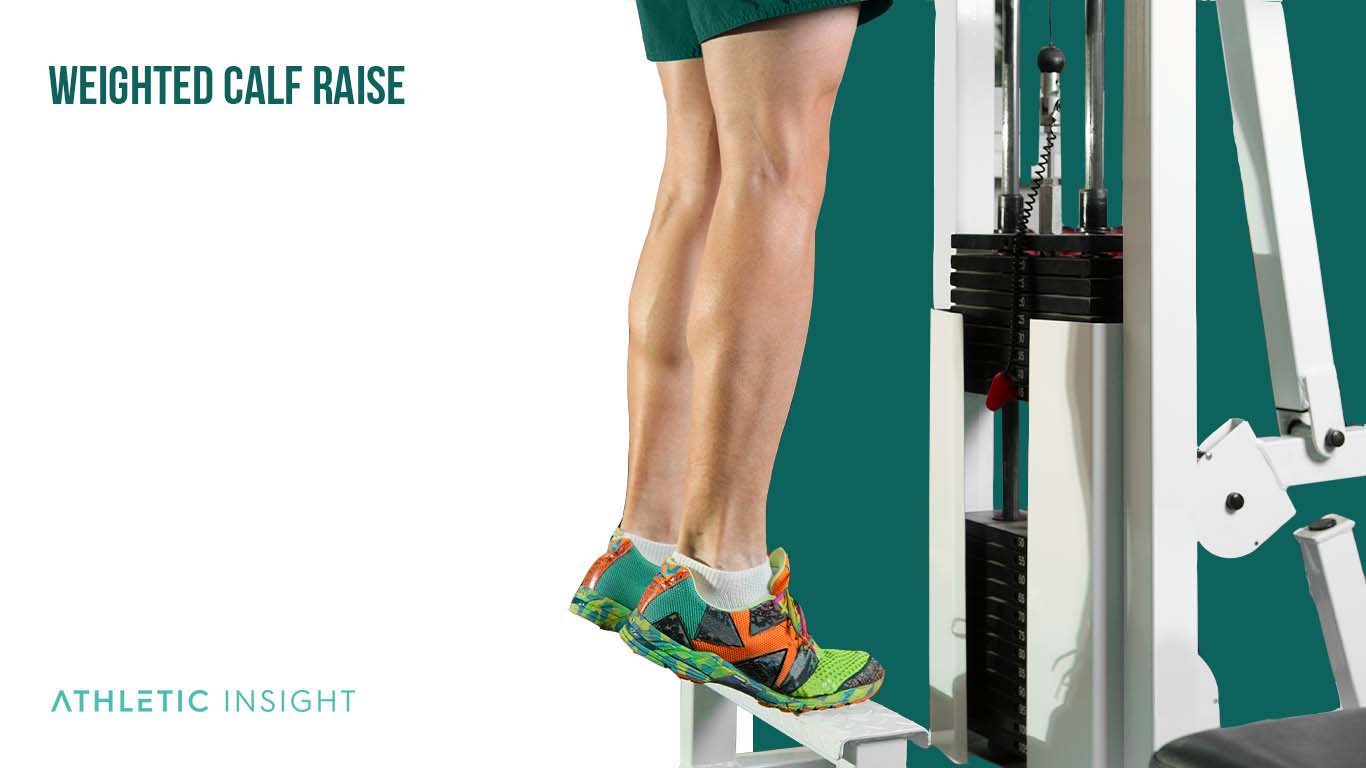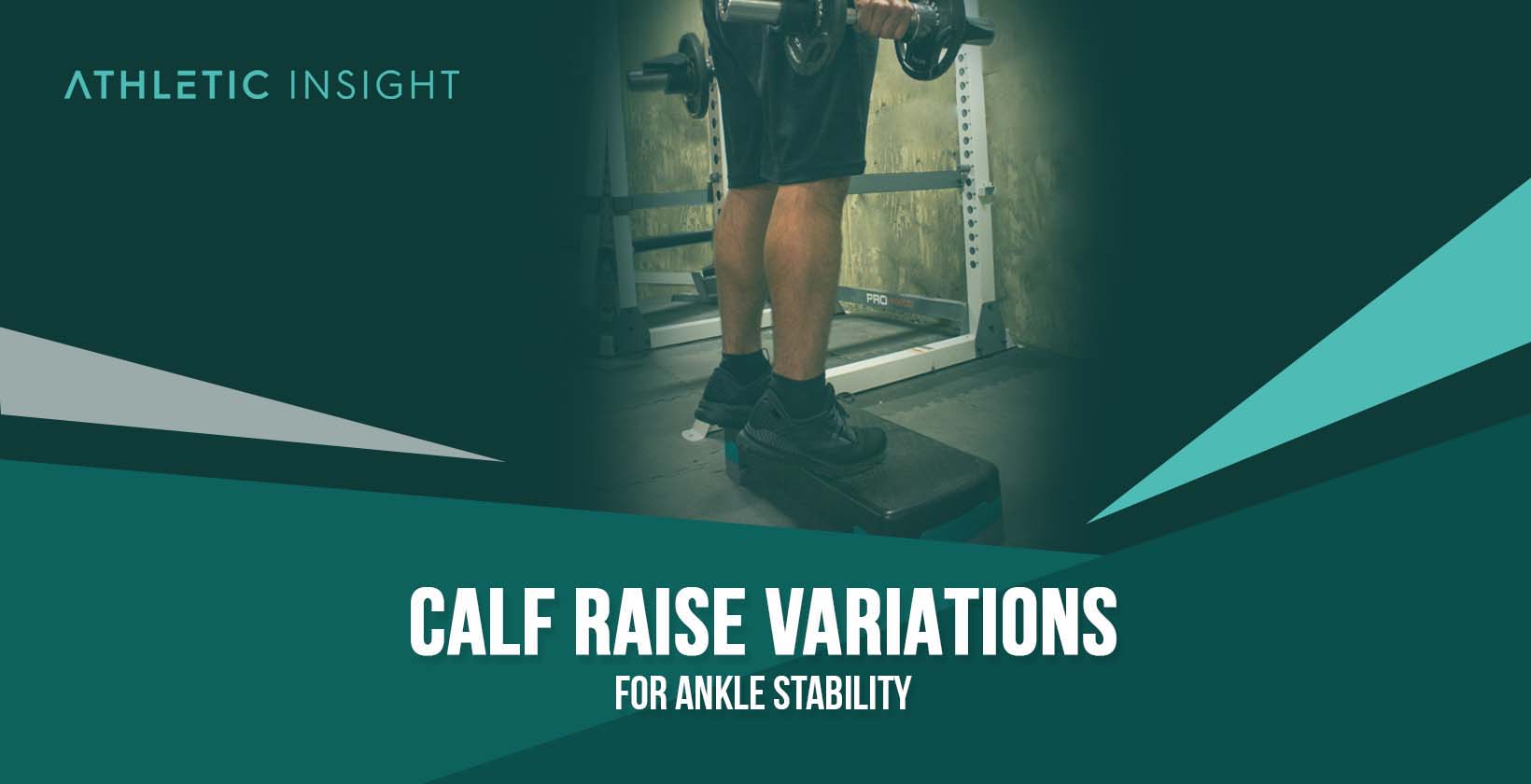Calf raises are an exercise that targets the lower leg muscles and increases endurance. Typically, a calf raise takes you from a falt-footed position to standing on your toes. You can add weights for further benefit to the peroneals, soleus, tibialis posterior, and gastrocnemius muscles.
Specifically, a calf raise consists of standing completely straight, pushing up the heels of your feet until only the very front of your feet are touching the ground, then lowering back down. Because of how simple calf raises are and the lack of necessary equipment, they are ideal for everyday life.
Variations to these raises, also known as calf raise variations, are vital because the musculature of the calves being hard to work. The muscles that make up the calves, the larger gastrocnemius, and the smaller soleus are connected towards the ankle by sturdy tissue. There is a third muscular formation called the plantar muscle within your leg that completes the triceps surae muscle of the calves.
The main classifications of calf raises include names like the following.
- The classic raises, or standing calf raise
- The seated calf raise
- The three-way calf raise
- Forms of weighted calf raise
- Donkey calf raise
- Trap bar calves raise variation
- The leg press calf raise
- Single-leg calf raise
- Kettlebell calves raise variation
Weight-related variations on existing calf raises might have “weighted” tacked on for the sake of understanding in guides and exercise regimens.
1. Seated Calf Raise
The seated calf raise is a calf raise variation that focuses on the soleus muscle. It’s best for athletes who sprint as it increases the size and strength of the calf muscle.
You can perform this variation without worrying about losing your balance or relying on your entire weight during the exercise.
Calf raise variations that involve weights work well in a routine with the seated calf raise. Taking a dumbbell or similar weight and placing it on top of your knee can allow you to work out the soleus without strain on the rest of your body.
A common mistake while performing the seated calf raise is relaxing your leg muscles. Even if you can take things a bit easier thanks to being seated, you still need to focus on working your calves in earnest. Since the closely-bundled muscles are hard to train, you need to take care to treat any calf exercise more seriously.
Once you become proficient with the proper form for this exercise variation, you can practice it with larger weights to build muscle. Depending on whether you do the seated calf raise with both legs or added weights, the exercise can be simple or challenging. Beginners should start with a standard seated calf raise and add weights as you go.
It’s easy to retain your form during the seated calf raise. Since the exercise is seated, it is easier on beginners than some of the other exercises listed here.
2. Weighted Calf Raise
The weighted calf raise variation focuses on the peroneal muscle. It’s best for athletes who need good balance as it increases the strength of your ankles. The weighted calf raise can describe a wide variety of calf raise variations. The most straightforward approach to the weighted calf raise variation is to hold dumbbells while performing a standing calf raise.

A benefit of a weighted calf raise is that it is more targeted towards muscle growth and balance, which is great for runners or athletes who rely on leg strength.
Other methods of incorporating weights include standing with a barbell over your back or incorporating a machine’s help. Thanks to the adaptability of this variation, it works well with athletes, strongmen, and even casual gym-goers. The amount of effort you take in setting up this calf raise variation is indicative of the gains you can receive.
The standing weighted calf raise focuses on the larger of the two calf muscles, the gastrocnemius, like any standing calf raise variation does. Standing straight and keeping your core engaged during repetitions are two vital parts of proper form for this variation. Good posture has the small added benefit of working out your core muscles to a degree.
One easy mistake to make while doing weighted calf raises is letting other parts of your body pick up the slack for your calves. The added weights can make it tempting to start moving your arms around, given how little your body will feel the movement otherwise.
For a comfortable experience, try to keep the rest of your body as stationary as you comfortably can. Let your core and arms handle the work of keeping your back straight and the extra weights in place. Your calves are the focus of your workout, so let them do the brunt of the work.
The added strain of holding weights in one position can make this variation harder to perform. It is barely an intermediate difficulty exercise and can become somewhat harder or easier depending on how you grip the dumbbells, bar, or machine in question.
3. Single-Leg Calf Raise
The single-leg calf raise variation focuses on the gastrocnemius muscle. It’s best for runners who need good balance, as it strengthens both the lower leg and the ankle.
The way this calf raises variation forces one leg to do the entirety of the work at a time. You will curl your other foot behind your calf while performing the same motion in the standard calf raise. If one of your calves is stronger than the other, it can often do more work doing a default raise.
With a single-leg calf raise, you can better balance the work between your legs, which is one of the benefits of doing a single-leg calf raise instead of a double-leg calf raise. You can augment this calf raise variation by holding weights the same way you would do the regular exercise.
A common mistake that can occur while performing this variation of calf raise is not using a wall or workout machine to steady yourself. Despite being as easy to set up as a standard calf raise, you can lose balance far more quickly.
If you make sure to use a wall as a steady surface and not as an aid in lifting your weight, you can more efficiently work your calf. Like many other calves raise variations, make sure to focus on a controlled tempo rather than trying to rush through repetitions.
While this variation on the calf raise is slightly more complex than the default one, it is still easy to maintain proper form with the aid of a stable structure to help you balance.
4. Bent-Knee Calf Raise
The bent-knee calf raise variation focuses on the soleus muscle. It’s best for athletes who need to improve their jumping distance to strengthen the lower leg and increase speed.
After assuming a standing position, bend at your knees before lifting your calves like you would in the standard exercise. It’s easy to incorporate weights in variations of the bent-knee calf raise by holding a barbell above your back or holding dumbbells in either hand.
Make sure to keep your upper and lower back flush without slouching. Especially if you use extra weight and need to lean forward, it can be easy to make the mistake of bending accidentally.
This variation targets the soleus muscle and can be more effective if you keep your balance across your body.
Doing small balance exercises before adding weights to the mix can bring the intensity of this workout up a great deal. You can also try to utilize a balance wall or workout machine while picking up one of your legs before performing this exercise.
This is the most difficult to keep a proper form of the calf raise variations of the listed calf. One mistake you can make in form is to slouch during the exercise. Be sure to keep a straight back.
5. Raised Calf Raise
The raised calf raise variation focuses on the soleus muscle. It’s best for bodybuilders who want to increase their leg mass as it strengthens and adds volume. The increased range of motion involved in raised calf raises stretches the ankle joint in addition to working the primary two calf muscles.
The benefit of a raised calf variation exercise is the extra range of movement and the focus on a different muscle group than a regular calf raise.
Just like regular calf raises, you can find further variations thanks to weights. As long as you are on an elevated surface like an aerobics platform or other step, you can add dumbbells or a barbell to enhance your experience.
Make sure to use a wall or other sturdy machine to improve your balance if you’re feeling uneasy while performing this exercise. Suddenly trying a variation of calf raise that requires more balance is difficult without practice, and using a stabilizer to help you doesn’t hurt the quality of your workout if you are keeping good form.
Even if you don’t have a dedicated aerobics step or other gym-centric platforms, you can perform raised calf raises from any elevated areas that let you fully stretch out. Remember to keep the highest position possible while performing each rep.
As long as you can get used to the extra balance necessary to do this exercise, the proper form is not hard to maintain.
What To Know About Calf Raise Variations?
There are benefits to different calf raise variations compared to the standard calf raise. Thanks to the variety of athletes, bodybuilders, and gym-goers that have been performing the calf raise for so long, new types have continued to develop.

Facts about calf raise alternatives are listed below.
- Muscle growth: Calf raise alternatives can benefit certain muscle groups better than the standard calf raise. Most standing calf raises prioritize the gastrocnemius, the larger of the two primary calf muscles. Variations like the sitting and bent-knee calf raise allow you to focus on the soleus instead.
- Balance aid: Calf raises alternatives often involve a vital balance component. While trying them at first can lead to awkwardness, it will slowly improve your balance, just like working out improves other aspects of your health.
- Improvised exercise: Many alternatives to the calf raise are just as versatile as the standard calf raise. Even without weights, you can still perform variations like the elevated calf raise with reasonable substitutes to gym equipment.
Calf raise variations allow you to access benefits from the standard exercise as well as unique bonuses you’d expect from other workouts. Many variations will enable you to customize muscle growth, improve your balance, and can be performed almost anywhere.
What are common mistakes in doing the Calf Raise Variations?
There are some easy mistakes to make when changing from the default calf raise to its many variations. Some possible errors include the following.
- Letting one of your calves handle more weight than the other is easy if you aren’t closely tracking your development. It’s hard to identify this habit and can be mitigated by performing single-leg calf raise variations.
- If you aren’t comfortable with your footing while performing a calf raise, you lose out on the focus of improving your calves when you wobble.
- Because of the relative simplicity of each exercise, it can become easy to rush through repetitions. The slow pace of each rep is what gives the most muscle gain.
Which type of Calf Raise variation is beginner-friendly?
A calf raise variation that is beginner-friendly requires no equipment and takes after the standard calf raise. One such variation is the 3-way calf raise or the seated cafe raise without weights.
It helps develop strength across multiple calf muscles by utilizing different angels during the same basic movement.
Mixing angles that point your toes tougher and away from one another is the key to mastering this calf raise. By default, one of the three methods of performing the 3-way calf raise is the same as the basic variation.
Make sure to take the same care in doing your repetitions slowly and deliberately as you do for the normal variation. This variation takes time to get used to if you are familiar with standard calf raises.
Which type of Calf Raise variation is good for weightlifters?
The Kettlebell calf raise variation is good for weightlifters because it combines the focus of weightlifting with the benefits of calf raises. It should be used by comfortable gym users that can make the most of a kettlebell in each hand.
Balance leads to the main mistake concerning this variation of calf raise. If you feel the need, you can try using just one kettlebell and letting your free hand hold onto a wall or other structure.
Holding the motion of your raises at the very top, even with the added difficulty of your weights, is an ideal way of taking advantage of this variation. Another tip for improving this exercise’s effectiveness is staying at a resting position for a shorter and shorter amount of time for each new set of repetitions you perform.
Kettlebells make this variation a bit more challenging to hold a proper form throughout, but not more so than most weighted calves raises variants.
Which type of Calf Raise variation is good for athletes?
A good calf raise variation for athletes is the elevated calf raise is a variation as it transitions into many other aerobic workouts best. This variation’s increased range of motion acts as a fantastic beginning to stretching out the ankles and legs.
This extra variation is customizable to the standards and goals of each athlete. Make sure to take advantage of tools around the gym and even in your own home to make the most of your repetitions. Elevated calf raises are possible from even the stairs in your home.
Which type of Calf Raise variation is good for bodybuilders?
A good calf raise variation for bodybuilders is the bent-knee variety. Incorporating heavier weights in a barbell kept above your back is an excellent way of pushing your calves to their limit while keeping your core engaged.
While you can still perform this variation without excess weights and gain a benefit, the similarity to other lifting motions and the nice leg workout you get from this exercise are hard to beat.
The tricky aspects of utilizing this variation come from the stringent form you need to follow. Keeping your knees equally bent and consistent throughout will take some practice. In addition, make sure to keep your back aligned, even if you have extra weight on your shoulders to contend with.
Which Calf Raise Variation is more difficult than Regular Calf Raise?
The calf raise variation that is more difficult than the regular version is weighted calf raises, which are higher intensity. Adding weights to any of the calf raise variations adds a new level of difficulty.
Introducing weights to any variation can add necessary intensity to an otherwise dull set of repetitions. The type of weight, be it barbell or dumbbells, can affect how comfortable you are with the exercise.
The same tips and potential mistakes that apply to the basic calf raise apply to any weighted variant. It is riskier the more weight you add to the exercise.
Which Calf Raise Type Aims the Legs more?
The calf raise type that aims at the legs more is the single-leg calf raise, allowing athletes to precisely train each of their legs rather than potentially falling into bad habits of a single leg doing more work.
The balance and overall lower leg power of working with one leg at a time are increased than dual-leg variations. Make sure not to get caught up in the “race” of making repetitions faster to compensate for working on each calf individually. Attempting to cheat a time commitment will undo any progress made while exercising.
Do Calf Raise Variations Act on Different Muscles?
No, calf raise variations do not act on many different muscles. The calf is made of two primary muscles, which means that most variations target one or the other. Standing versus seated or other augmented variations will change focus from the larger gastrocnemius to the soleus and vice versa.
What Are the alternatives of Calf Raise Exercises?
Calf raise alternatives include lower leg exercises and aerobic workouts of all kinds. Calf raise alternative options include the following.
- Running
- Climbing
- Squat heel raises
- Jump rope
- Box jumps



